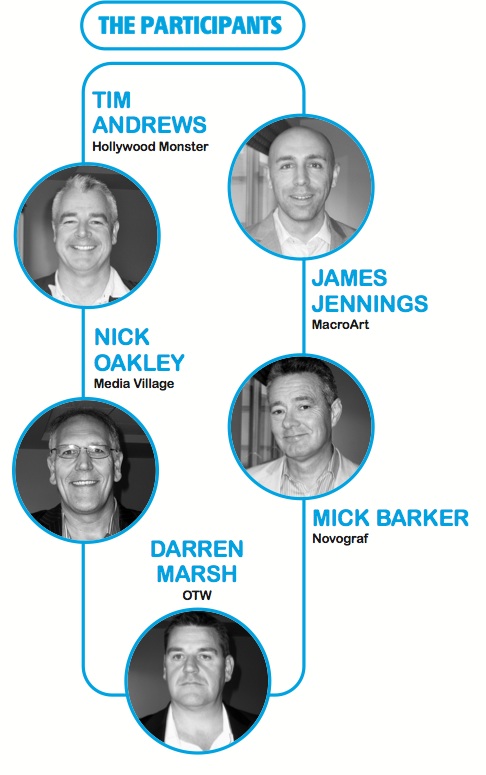It’s again time for Image Reports to hand out its annual Angel Awards in recognition of products, introduced to the UK during the last year, which it considers most innovative and likely to have an impact in the wide-format sector. The winners in 2012 are…
Features
IR talks to ….. Duncan MacOwan, Fespa
Towards the end of January Fespa will bring its annual Global Summit to the UK. And this year, Fespa is throwing open the doors to what has previously been an ‘invite only’ event for the industry’s top brass. It’s where the great and the good meet to take the temperature of the wide-format market and discuss the way forward. So is it worth putting your hand in your pocket to get an insider’s perspective at the 2013 summit? I ask Fespa’s Duncan MacOwan, what’s in it for printers?
Round Table: Widthwise 2012
Grassroots players, Tim Andrews from Hollywood Monster, James Jennings from MacroArt, Nick Oakley from Media Village, Mick Barker from Novograf and Darren Marsh from OTW, discuss the findings of the annual Widthwise wide-format market survey and chew over the main issues of the day.
Agfa Jeti 3020 Titan
Melony Rocque-Hewitt looks at how this printer could grow with your business.
It is nearly two years ago now that Agfa completed its purchase of Gandi Innovations. The sale allowed Agfa to plug an obvious hole in its hardware arsenal, and since then, the company has bought two machines to market, the development of which was well-established by Gandi and then picked up and completed by Agfa.
Bringing us back from the brink
The last issue provided a synopsis of the Image Reports panel discussion: ‘Can you sell your sustainability USP as a printer?’ This month, we look at some of the key arguments aired at EcoPrint over why you need to take sustainability seriously even if you can’t.
Not just converted but evangelical is how I’d describe the keynote speakers at EcoPrint, and listening to them explain why the issue of sustainability is of intrinsic importance to our future it’s difficult not to be swayed by their fervour.
Christmas shopping
How does wide-format digital print put consumers in the mood to shop ‘till they drop? Melony Rocque-Hewitt investigates.
When Halloween is finished and the last sparkler has gone cold from Bonfire Night, the cascading rush for all things Christmas explodes. For many PSPs, the week commencing 5 November is often one of the busiest of the year as clients ready themselves for their Christmas campaigns.
Counting the cost
A look at what you’ll get for your money if you attend the Fespa Global Summit 2013.
Traditionally printers aren’t very good at forking out for strategic business insight, but tradition is out of the window as those attending the third Fespa Global Summit will understand. The pace of change all around us means that to run a sustainable business owners/managers need to know all there possibly is to know about the issues affecting a company’s profitability and longevity.
The tools of success
You don’t need to know the ins and outs of wide-format production. You don’t even need your own kit, you just need a vision of what diversifying into large format can do for your business and then it’s just a matter of partnering with the right company…
Protecting your online reputation
Mark Hall, managing director of online reputation management consultancy Got Juice, explains why all businesses need to take their online reputation management seriously.
Follow my leader
Is David Cameron playing games with us when it comes to environmental policy? Is the man who promised “the greenest government ever” leading from the front or tagging along at the back?
Logical but stupid
In 2006, Disney paid £4.1bn to buy Pixar, the animation studio that had created such gems as ‘Toy Story’, ‘Finding Nemo’ and ‘The Incredibles’. As it turned out, that price was probably a bargain but Disney could have saved billions if its management hadn’t made the wrong call in the 1980s.
The irony is that a studio founded by master animator Walt Disney, that had been responsible for such marvels as ‘Snow White And The Seven Dwarfs’, had to pay so much to get back into a market it had once dominated. That’s because in the early 1980s – with the studio’s founding genius long dead – the company’s traditional values led it astray. Because traditional 2D animation required so much skill and resource, Disney had come to focus on blockbusters. So in 1982, when it delved into computer graphics to produce ‘Tron’, it looked at what it considered so-so grosses for the sci-fi feature and made the logical, but stupid, decision not to venture any further into computer graphics. Four years later, Pixar was founded when Steve Jobs bought the computer graphics of Lucasfilm. Within eight years, the new company was cooperating with Disney. The dissolution of that partnership in 2004 convinced Walt’s old firm it had to act – and it made a £4.1bn offer Pixar’s owners could not refuse.
If Disney had taken a longer, broader view of ‘Tron’, seeing the movie not just as a one-off item on a profit and loss account but as an investment in the cutting edge technology of computer graphics, Pixar might never have happened. Although this blunder gave the world ‘Toy Story’, it is a salutary reminder that merely by applying the conventional wisdom – or judging every project according to its traditional values – every company can get it spectacularly, expensively wrong.
You have to start somewhere
Technology must always be useful, the British scientist Sir Patrick Linstead once observed, whereas science need not be. In the wide-format industry, too many technologies have proved not be as useful as the printing companies who bought them had hoped. So it is easy to understand why, despite all the hype, many companies have been reluctant to embrace Web2Print.
Yet those helpful folks at OnPrint Shop (www.onprintshop.com/eight-steps-for-sme-printers-to-choose-right-web2print-solution.html) have chipped in with a handy eight-step guide to making the most of this new technology which sums up the challenges in plain English, raising such basic questions as why do you need to go online before ending with a cautious analysis of the investment options – from renting to sharing and licensing. The best single piece of advice? “Companies usually give only ‘how to do’ support, which is not that helpful if you’re not IT savvy. Look for a company that helps you set up your online store and makes you functional in a short time.”







